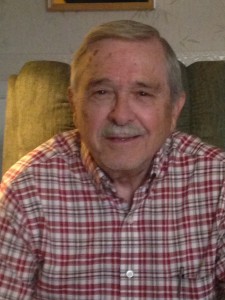 Jerry Wilson started his career at Oklahoma A&M (now called Oklahoma State University) where he worked in a Biochemistry lab for two years and got his B.S. in Chemistry in 1961. After his bachelors, he was in the army ROTC for two years at Fort Bragg where he supported immediate response groups, specifically the eighteenth core.
Jerry Wilson started his career at Oklahoma A&M (now called Oklahoma State University) where he worked in a Biochemistry lab for two years and got his B.S. in Chemistry in 1961. After his bachelors, he was in the army ROTC for two years at Fort Bragg where he supported immediate response groups, specifically the eighteenth core.
After leaving the army, he worked on his PhD at the University of Oklahoma from 1963-1967. He worked under Dr. Wender, a Biochemist, on air pollutants and their effect on agricultural plants. Also, the gas chromatograph (GC) had just come on the market, so Jerry was among the first to use a GC to analyze his samples. There he was put in charge of the instrument and gained an expertise in gas chromatography. Aside from air pollutants, he also worked to analyze tobacco extracts with chemical techniques. Due to the immense amount of work he had done with a GC, he began to consider himself as more of an Analytical Chemist than a Biochemist.
Jerry wrote a proposal to work on enzymes through Dr. Con, and earned an NSF Research Fellowship granting him a post-doc position in the Biochem department at UC Davis from 1967-1969. Back then it was located in Hutchison Hall. It was not until the end of his post-doc that the department moved to its current location at Briggs. During his post-doc he was able to get an interview at Sacramento State University which would lead him to the next chapter of his life.
He worked for a total of thirty five years at Sacramento State teaching biochemistry labs, some lectures, and some freshman chemistry labs. During his teaching career he had a total of three masters students. Though he lost touch with two of them, he is very proud that one of his students, Sam Lee, became a senior criminologist in the Los Angeles County Police Department.
In the middle of his teaching career at Sac State, around 1978-1980, Jerry realized the money was not as good as he had hoped. He then took a leave from Sac State and started working in an Analytical Lab. With two others, they bought the California Analytical Laboratories. The lab he worked in was involved in many of the first EPA studies for chemical pollution in water, pesticides, paint, and others. He was also amongst the first scientists to use the first GC/MS combinations. At another lab, Carborundum Corporation, he analyzed volatiles with a GC.
When Jerry decided to return to Sac State he met a person who worked for the criminal justice system. With methamphetamines becoming more of a problem, many defense attorneys requested him to look at their cases. With much of the police and law enforcement not fully understanding the logic of theoretical yield vs. experimental yield, Jerry played a pivotal role in providing a scientific standpoint so the court would make the best decision they could. He was requested by attorneys in Sacramento, Nevada, Fresno, and Contra Costa counties. Due to Jerry’s immense contributions to the criminal justice system, judges started realizing that if they are going to do science, it should be good science. In one case, expecting a theoretical yield the lawyers argued for 100% conversion to methamphetamine. With Jerry stating it was likely more around a 50% conversion, the judge made the court re-evaluate and reach a new estimate of 70% yield. Looking back, though Jerry has seen improvements in technologies he still thinks there is not enough consistency with these kinds of cases. Though, he does believe the DNA cases have gotten more reliable. Jerry states, “Forensic science is a great future for chemists. You just have to decide if you want to be a chemist or a cop”.
Jerry retired in 2002, but still wanted to earn some money. He started a lab in his garage to work on protein research for many years, but started looking elsewhere after realizing he did not have the money to buy the necessary apparatus anymore. Through his wife’s friend, he met an Organic Geochemist named Peter Hernes at UC Davis and got a job working in the hydrology department doing gas chromatography and analytical chemistry where he still works to this very day.
Jerry looks back fondly on his experience with ACS when he was program chairman and treasurer for the Sacramento section of ACS during his teaching career. The only person he knows who is still on the committee is Jan Hayes.
Looking back, he remains thankful to his high school chemistry teacher with whom he took two years of chemistry. With this excellent instruction, Jerry got into the advanced freshman chemistry class in college and had no trouble. He is also very thankful to Dr. Con who helped him network throughout his life, and is also thankful and proud of his family of four children and one grandson.
